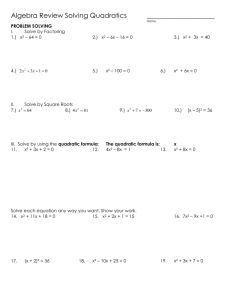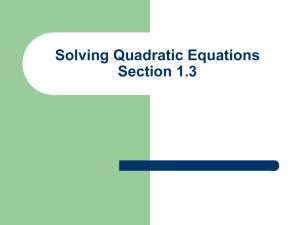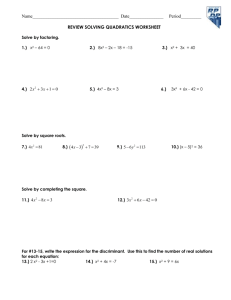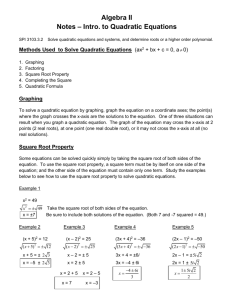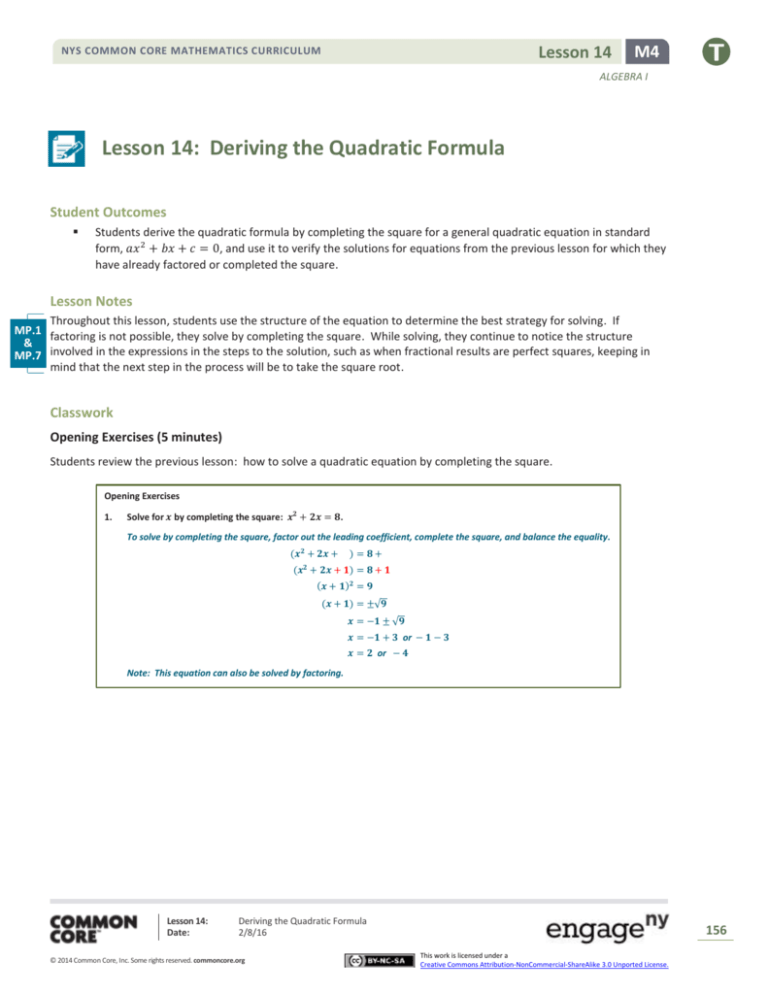
Lesson 14
NYS COMMON CORE MATHEMATICS CURRICULUM
M4
ALGEBRA I
Lesson 14: Deriving the Quadratic Formula
Student Outcomes
Students derive the quadratic formula by completing the square for a general quadratic equation in standard
form, 𝑎𝑥 2 + 𝑏𝑥 + 𝑐 = 0, and use it to verify the solutions for equations from the previous lesson for which they
have already factored or completed the square.
Lesson Notes
Throughout this lesson, students use the structure of the equation to determine the best strategy for solving. If
MP.1 factoring is not possible, they solve by completing the square. While solving, they continue to notice the structure
&
MP.7 involved in the expressions in the steps to the solution, such as when fractional results are perfect squares, keeping in
mind that the next step in the process will be to take the square root.
Classwork
Opening Exercises (5 minutes)
Students review the previous lesson: how to solve a quadratic equation by completing the square.
Opening Exercises
1.
Solve for 𝒙 by completing the square: 𝒙𝟐 + 𝟐𝒙 = 𝟖.
To solve by completing the square, factor out the leading coefficient, complete the square, and balance the equality.
(𝒙𝟐 + 𝟐𝒙 +
)=𝟖+
(𝒙𝟐 + 𝟐𝒙 + 𝟏) = 𝟖 + 𝟏
(𝒙 + 𝟏)𝟐 = 𝟗
(𝒙 + 𝟏) = ±√𝟗
𝒙 = −𝟏 ± √𝟗
𝒙 = −𝟏 + 𝟑 or − 𝟏 − 𝟑
𝒙 = 𝟐 or − 𝟒
Note: This equation can also be solved by factoring.
Lesson 14:
Date:
Deriving the Quadratic Formula
2/8/16
© 2014 Common Core, Inc. Some rights reserved. commoncore.org
156
This work is licensed under a
Creative Commons Attribution-NonCommercial-ShareAlike 3.0 Unported License.
Lesson 14
NYS COMMON CORE MATHEMATICS CURRICULUM
M4
ALGEBRA I
Solve for 𝒑 by completing the square: 𝟕𝒑𝟐 − 𝟏𝟐𝒑 + 𝟒 = 𝟎.
2.
To solve by completing the square, first gather the variable terms to one side of the equation and factor out the
leading coefficient.
𝟕𝒑𝟐 − 𝟏𝟐𝒑 = −𝟒
𝟕 (𝒑𝟐 −
𝟏𝟐
𝟔 𝟐
𝟕(𝟑𝟔)
𝒑 + ( ) ) = −𝟒 +
𝟕
𝟕
𝟒𝟗
𝟔 𝟐
𝟑𝟔
𝟕 (𝒑– ) = −𝟒 +
𝟕
𝟕
𝟔 𝟐 𝟖
𝟕 (𝒑 − ) =
𝟕
𝟕
𝟔 𝟐
𝟖
(𝒑 − ) =
𝟕
𝟒𝟗
𝟔
√𝟖
(𝒑 − ) = ±
𝟕
𝟕
𝒑=
𝟔 √𝟖
±
OR approximately 𝟏. 𝟐𝟔 or 𝟎 . 𝟒𝟓
𝟕
𝟕
Which of these problems makes more sense to solve by completing the square? Which makes more sense to
solve by factoring? How could you tell early in the problem solving process which strategy to use?
The best strategy for solving the second equation is by completing the square, while the first equation
can be easily factored using product-sum. You can see this from the solutions since the first set of
solutions is rational. To tell right away which of the expressions can be factored easily, test the sum
and the product.
Discussion (12 minutes)
Have students start with solving the general form of a one-variable linear equation, 𝑎𝑥 + 𝑏 = 0, for 𝑥.
How would you solve this equation for 𝑥: 𝑎𝑥 + 𝑏 = 0, where 𝑎 and 𝑏 could be replaced with any numbers?
Isolate the 𝑥-term and then divide by the leading coefficient:
𝑏
𝑎𝑥 = −𝑏 → 𝑥 = − .
𝑎
𝑏
𝑎
Can we say that − is a “formula” for solving any equation in the form 𝑎𝑥 + 𝑏 = 0?
Yes, it will always give us the value for 𝑥, based on the values of 𝑎 and 𝑏.
As students discuss the following questions, guide them to realize that the parameters of a quadratic are the key to
determining the best entry point for solving an equation. Then, follow up by having students work in pairs or small
groups to try to solve the standard form of a one-variable quadratic equation, 𝑎𝑥 2 + 𝑏𝑥 + 𝑐 = 0, for 𝑥.
What factors determine how we solve an equation and what the solutions are? What makes the first Opening
Exercise different from the second?
The coefficients of the quadratic and linear terms, 𝑎 and 𝑏, along with the constant, 𝑐, of the quadratic
equation in standard form are what make the solution unique.
Lesson 14:
Date:
Deriving the Quadratic Formula
2/8/16
© 2014 Common Core, Inc. Some rights reserved. commoncore.org
157
This work is licensed under a
Creative Commons Attribution-NonCommercial-ShareAlike 3.0 Unported License.
Lesson 14
NYS COMMON CORE MATHEMATICS CURRICULUM
M4
ALGEBRA I
What would happen if we tried to come up with a way to use just the values of 𝑎, 𝑏, and 𝑐 to solve a quadratic
equation? Can we solve the general quadratic equation 𝑎𝑥 2 + 𝑏𝑥 + 𝑐 = 0? Is this even possible? Which
method would make more sense to use, factoring or completing the square?
Encourage students to play around with this idea for a few minutes. You may even point them in the right
direction by asking questions such as the following: Can we factor if we don’t know the coefficients―using 𝑎, 𝑏,
and 𝑐, rather than numbers? Can we complete the square using only 𝑎, 𝑏, and 𝑐?
Ultimately, show students how to derive the quadratic formula by completing the square and have them record this in
the space provided in the student handout.
Discussion
Solve 𝒂𝒙𝟐 + 𝒃𝒙 + 𝒄 = 𝟎.
𝑎𝑥 2 + 𝑏𝑥 + 𝑐 = 0
The steps:
𝑏
𝑎 (𝑥 2 + 𝑥 + ___) = −𝑐
𝑎
𝑏
𝑏 2
𝑏 2
𝑎 (𝑥 2 + 𝑥 + ( ) ) = −𝑐 + 𝑎 ( )
𝑎
2𝑎
2𝑎
Gather the variable terms, and factor out the leading coefficient.
Complete the square inside the parentheses, and balance the
equality.
1
𝑏
𝑏 2
𝑐
𝑏2
(𝑥 2 + 𝑥 + ( ) ) = − + ( 2 )
𝑎
2𝑎
𝑎
4𝑎
2
𝑏
−4𝑎(𝑐) 𝑏 2
𝑏 2 − 4𝑎𝑐
(𝑥 + ( )) =
+ 2=
2𝑎
4𝑎(𝑎)
4𝑎
4𝑎2
(𝑥 +
𝑏
𝑥=−
±
2𝑎
𝑏
𝑏 2 − 4𝑎𝑐
) = ±√
2𝑎
4𝑎2
√𝑏 2
√𝑏 2
− 4𝑎𝑐 −𝑏 ±
− 4𝑎𝑐
=
2𝑎
2𝑎
Now, simplify the fraction on the right and multiply both sides by .
𝑎
Remember that 𝑎 ≠ 0 since that would make the original equation
not quadratic.
Factor the perfect square on the left and clean up the right. Be
careful. You need to combine the two fractions on the right by
finding the common denominator. Use the commutative property to
reverse the two fractions on the right.
Now, combine the two right-side fractions, and take the square root
of both sides. Notice that the denominator is a perfect square, and
do not forget the ±.
Add
−𝑏
2𝑎
to both sides to finally solve for 𝑥. The final step is
combining the two fractions, which have the same denominator
since we took the square root of 4𝑎2 .
Then discuss by asking the following:
How can we verify that this formula is correct?
Encourage students to review problems from the Opening Exercises and see if they get the same answers using the
quadratic formula that they got by completing the square for the standard form of a quadratic equation.
Make sure students put the equation in standard form before solving; otherwise, the quadratic formula will not work.
Lesson 14:
Date:
Deriving the Quadratic Formula
2/8/16
© 2014 Common Core, Inc. Some rights reserved. commoncore.org
158
This work is licensed under a
Creative Commons Attribution-NonCommercial-ShareAlike 3.0 Unported License.
Lesson 14
NYS COMMON CORE MATHEMATICS CURRICULUM
M4
ALGEBRA I
Now try solving the equations in the Opening Exercises using the quadratic formula. Check your answers to
make sure they are correct.
𝑥 2 + 2𝑥 = 8 → 𝑥 2 + 2𝑥 − 8 = 0 → 𝑎 = 1, 𝑏 = 2, 𝑐 = −8 (The negative is important here!)
𝑥=
−2 ± √22 − 4(1)(−8) −2 ± √4 + 32 −2 ± √36 −2 ± 6
=
=
=
= 2 or − 4
2(1)
2
2
2
Now check: Substitute 2 and −4 into the original equation. Is (2)2 + 2(2) = 8? → 4 + 4 = 8.
Is (−4)2 + 2(−4) = 8? → 16 − 8 = 8. Or, look back at the first example to compare answers.
7𝑝2 − 12𝑝 + 4 = 0 → 𝑎 = 7, 𝑏 = −12, 𝑐 = 4
𝑥=
−(−12) ± √(−12)2 − 4(7)(4) 12 ± √144 − 112 12 ± √32
12 ± 4√2
6 ± 2√2
=
=
=
=
,
2(7)
14
14
14
7
which is approximately 1.26 or 0.45.
Have students check whether this matches the answers from the Opening Exercises.
Yes.
Note: The simplification of the square root would not be required to get the same decimal approximations.
Now, take a minute and have your students look closely at the quadratic formula. Point out that the whole
expression can be split into two separate expressions as follows:
−𝒃 ± √𝒃𝟐 − 𝟒𝒂𝒄
−𝒃 √𝒃𝟐 − 𝟒𝒂𝒄
=
±
.
𝟐𝒂
𝟐𝒂
𝟐𝒂
Notice that the first part of the expression (in red) represents the axis of symmetry (the 𝑥-coordinate for the
vertex). Now we step to the right and the left by the amount represented in blue to find the 𝑥-intercepts (i.e.,
zeros or roots). While it is never a good idea to offer memorization tricks as problem solving strategies, do not
be shy about using
−𝑏
2𝑎
, as it is presented here to quickly find the axis of symmetry and the vertex for a quadratic
function in standard form.
Exercises (12 minutes)
Have students work independently and check against their work from the previous lesson. If time is short, you might
select two of these exercises and move on to Exercise 5. Some of these are more challenging than others. If you shorten
this set, take the needs of your students into account.
After verifying that the Opening Exercises can be solved using the quadratic formula, return to the in-class exercises for
Lesson 13, and solve them using the quadratic formula. Check to make sure your answers are the same.
Exercises
Use the quadratic formula to solve each equation.
1.
𝒙𝟐 − 𝟐𝒙 = 𝟏𝟐 → 𝒂 = 𝟏, 𝒃 = −𝟐, 𝒄 = −𝟏𝟐 (Watch the negatives.)
𝒙=
𝟐 ± √(−𝟐)𝟐 − 𝟒(𝟏)(−𝟏𝟐) 𝟐 ± √𝟓𝟐 𝟐 ± √𝟒(𝟏𝟑) 𝟐 ± 𝟐√𝟏𝟑
=
=
=
= 𝟏 ± √𝟏𝟑
𝟐(𝟏)
𝟐
𝟐
𝟐
Lesson 14:
Date:
Deriving the Quadratic Formula
2/8/16
© 2014 Common Core, Inc. Some rights reserved. commoncore.org
159
This work is licensed under a
Creative Commons Attribution-NonCommercial-ShareAlike 3.0 Unported License.
Lesson 14
NYS COMMON CORE MATHEMATICS CURRICULUM
M4
ALGEBRA I
𝟏
2.
𝟐
𝒓𝟐 − 𝟔𝒓 = 𝟐 → 𝒂 =
𝒓=
𝟏
𝟐
, 𝒃 = −𝟔, 𝒄 = −𝟐 (Did you remember the negative?)
𝟏
𝟔 ± √(−𝟔)𝟐 − 𝟒 ( ) (−𝟐) 𝟔 ± √𝟑𝟔 + 𝟒
𝟐
=
= 𝟔 ± √𝟒(𝟏𝟎) = 𝟔 ± 𝟐√𝟏𝟎
𝟏
𝟏
𝟐( )
𝟐
𝟐𝒑𝟐 + 𝟖𝒑 = 𝟕 → 𝒂 = 𝟐, 𝒃 = 𝟖, 𝒄 = −𝟕
3.
𝒑=
−𝟖 ± √𝟖𝟐 − 𝟒(𝟐)(−𝟕) −𝟖 ± √𝟔𝟒 + 𝟓𝟔 −𝟖 ± √𝟒(𝟑𝟎) −𝟖 ± 𝟐√𝟑𝟎 −𝟒 ± √𝟑𝟎
=
=
=
=
𝟐(𝟐)
𝟒
𝟒
𝟒
𝟐
= approximately 𝟎. 𝟕𝟑𝟗 or −𝟒. 𝟕𝟑𝟗.
𝟏𝟓
Note: In the Lesson 13 problem, the radical in the final answer was √
, which is equivalent to
√𝟑𝟎
.
𝟐
𝟐𝒚𝟐 + 𝟑𝒚 − 𝟓 = 𝟒 → 𝒂 = 𝟐, 𝒃 = 𝟑, 𝒄 = −𝟗
4.
𝒚=
𝟐
−𝟑 ± √𝟑𝟐 − 𝟒(𝟐)(−𝟗) −𝟑 ± √𝟗 + 𝟕𝟐 −𝟑 ± √𝟖𝟏 −𝟑 ± 𝟗 𝟑
=
=
=
= or − 𝟑
𝟐(𝟐)
𝟒
𝟒
𝟒
𝟐
Based on the original equation, which of the problems in the exercises would be best solved using the quadratic
formula?
Exercises 1–3 would need to be solved by using either the quadratic formula or by completing the
square. Exercise 4 could be factored.
Exercise 5 (7 minutes)
Have students work with a partner or in small groups to solve the following equations, using a different method for each:
solve by factoring, solve by completing the square, and solve using the quadratic formula. Before they begin, ask them
to consider the method they will use.
Exercise 5
Solve these quadratic equations, using a different method for each: solve by factoring, solve by completing the square,
and solve using the quadratic formula. Before starting, indicate which method you will use for each.
Method
by factoring
Method
𝟐𝒙𝟐 + 𝟓𝒙 − 𝟑 = 𝟎
by quadratic formula
𝒙𝟐 + 𝟑𝒙 − 𝟓 = 𝟎
Method
𝟏
𝟐
by completing the square
𝒙𝟐 − 𝒙 − 𝟒 = 𝟎
(Students may choose any method to solve. However, the first and third are factorable, but the middle expression is not.)
(𝟐𝒙 − 𝟏)(𝒙 + 𝟑) = 𝟎
𝟏
𝒙 = or − 𝟑
𝟐
𝒙=
−𝟑 ± √𝟑𝟐 − 𝟒(𝟏)(−𝟓)
𝟐(𝟏)
−𝟑 ± √𝟐𝟗
𝟐
−𝟑 + √𝟐𝟗
−𝟑 − √𝟐𝟗
𝒙=
or
𝟐
𝟐
𝒙 ≈ 𝟏. 𝟏𝟗 or − 𝟒. 𝟏𝟗
𝒙=
Lesson 14:
Date:
𝟏 𝟐
(𝒙 − 𝟐𝒙
𝟐
)=𝟒
𝟏 𝟐
𝟏
(𝒙 − 𝟐𝒙 + 𝟏) = 𝟒 +
𝟐
𝟐
𝟏
𝟐
(𝒙 − 𝟏) = 𝟒. 𝟓
𝟐
(𝒙 − 𝟏)𝟐 = 𝟗
(𝒙 − 𝟏) = ±𝟑
𝒙 =𝟏±𝟑
𝒙 = 𝟒 or − 𝟐
Deriving the Quadratic Formula
2/8/16
© 2014 Common Core, Inc. Some rights reserved. commoncore.org
160
This work is licensed under a
Creative Commons Attribution-NonCommercial-ShareAlike 3.0 Unported License.
Lesson 14
NYS COMMON CORE MATHEMATICS CURRICULUM
M4
ALGEBRA I
Closing (4 minutes)
When is completing the square the most efficient method to use for solving a quadratic equation?
When is the quadratic formula best?
When it is not possible (or it is very difficult) to factor the quadratic expression, and when the leading
coefficient and/or linear term coefficient are fractions that are not easily eliminated.
When is factoring the most efficient method to use for solving a quadratic equation?
When it is not possible (or it is very difficult) to factor the quadratic expression, and when the leading
coefficient and linear term coefficient are easy to deal with (i.e., when the leading coefficient is easily
factored out resulting in an even linear term coefficient).
When the factors of the equation are obvious or fairly easy to find. When factoring out the GCF or
eliminating any fractional coefficients is possible.
Is using the quadratic formula really just completing the square? Why or why not?
Yes, using the quadratic formula is really solving by completing the square because the formula is
derived by completing the square for a quadratic equation in standard form. When we use the formula,
we are substituting values into the expression derived by completing the square.
Lesson Summary
𝟐
The quadratic formula, 𝒙 =
−𝒃 ± √𝒃 −𝟒𝒂𝒄
, is derived by completing the square on the general form of a quadratic
𝟐𝒂
equation: 𝒂𝒙𝟐 + 𝒃𝒙 + 𝒄 = 𝟎, where 𝒂 ≠ 𝟎. The formula can be used to solve any quadratic equation and is
especially useful for those that are not easily solved by using any other method (i.e., by factoring or completing the
square).
Exit Ticket (5 minutes)
Lesson 14:
Date:
Deriving the Quadratic Formula
2/8/16
© 2014 Common Core, Inc. Some rights reserved. commoncore.org
161
This work is licensed under a
Creative Commons Attribution-NonCommercial-ShareAlike 3.0 Unported License.
Lesson 14
NYS COMMON CORE MATHEMATICS CURRICULUM
M4
ALGEBRA I
Name ___________________________________________________
Date____________________
Lesson 14: Deriving the Quadratic Formula
Exit Ticket
Solve for 𝑅 using any method. Show your work.
3 2
𝑅 − 2𝑅 = 2
2
Lesson 14:
Date:
Deriving the Quadratic Formula
2/8/16
© 2014 Common Core, Inc. Some rights reserved. commoncore.org
162
This work is licensed under a
Creative Commons Attribution-NonCommercial-ShareAlike 3.0 Unported License.
Lesson 14
NYS COMMON CORE MATHEMATICS CURRICULUM
M4
ALGEBRA I
Exit Ticket Sample Solutions
Solve for 𝑹 using any method. Show your work.
𝟑 𝟐
𝑹 − 𝟐𝑹 = 𝟐
𝟐
Let’s start each method by multiplying both sides of the equation by 𝟐 to eliminate the fraction.
𝟑𝑹𝟐 − 𝟒𝑹 = 𝟒
By factoring:
By completing the square:
𝟐
𝟑𝑹 − 𝟒𝑹 − 𝟒 = 𝟎
(𝑹 − 𝟐)(𝟑𝑹 + 𝟐) = 𝟎
𝑹 = 𝟐 or −
𝟐
𝟑
By using the quadratic formula:
𝟒
𝟑 (𝑹𝟐 − 𝑹
)=𝟒
𝟑
𝟒
𝟐 𝟐
𝟐𝟐
𝟑 (𝑹𝟐 − 𝑹 + (− ) ) = 𝟒 +
𝟑
𝟑
𝟑
𝟑𝑹𝟐 − 𝟒𝑹 − 𝟒 = 𝟎
𝒂 = 𝟑, 𝒃 = −𝟒, and 𝒄 = −𝟒
𝑹=
𝟐
𝟒
𝟐
𝟏𝟐 𝟒
𝑹𝟐 − 𝑹 + (− ) =
+
𝟑
𝟑
𝟗 𝟗
𝟐 𝟐 𝟏𝟔
(𝑹 − ) =
𝟑
𝟗
𝑹−
𝟒 ± √𝟏𝟔 + 𝟒𝟖
𝟔
𝟒 ± √𝟔𝟒 𝟒 ± 𝟖
𝑹=
=
𝟔
𝟔
𝟐
𝑹 = 𝟐 or −
𝟑
𝑹=
𝟐
𝟏𝟔
= ±√
𝟑
𝟗
𝑹=
−(−𝟒) ± √(−𝟒)𝟐 − 𝟒(𝟑)(−𝟒)
𝟐(𝟑)
𝟐 𝟒
±
𝟑 𝟑
𝑹 = 𝟐 or −
𝟐
𝟑
Problem Set Sample Solutions
Use the quadratic formula to solve each equation.
1.
Solve for 𝒛: 𝒛𝟐 − 𝟑𝒛 − 𝟖 = 𝟎.
𝒂 = 𝟏, 𝒃 = −𝟑, 𝒄 = −𝟖
𝒛=
2.
−(−𝟑) ± √(−𝟑)𝟐 − 𝟒(𝟏)(−𝟖) 𝟑 ± √𝟒𝟏
=
𝟐(𝟏)
𝟐
Solve for 𝒒: 𝟐𝒒𝟐 − 𝟖 = 𝟑𝒒.
𝒂 = 𝟐, 𝒃 = −𝟑, 𝒄 = −𝟖
𝒒=
3.
−(−𝟑) ± √(−𝟑)𝟐 − 𝟒(𝟐)(−𝟖) 𝟑 ± √𝟕𝟑
=
𝟐(𝟐)
𝟒
Solve for 𝒎:
𝟏
𝟑
𝒎𝟐 + 𝟐𝒎 + 𝟖 = 𝟓.
𝟏
𝟑
𝒂 = , 𝒃 = 𝟐, 𝒄 = 𝟑
𝟏
−𝟐 ± √𝟐𝟐 − 𝟒 ( ) (𝟑) −𝟐 ± √𝟎
𝟑
𝒎=
=
= −𝟑
𝟏
𝟐
𝟐( )
𝟑
𝟑
Lesson 14:
Date:
Deriving the Quadratic Formula
2/8/16
© 2014 Common Core, Inc. Some rights reserved. commoncore.org
163
This work is licensed under a
Creative Commons Attribution-NonCommercial-ShareAlike 3.0 Unported License.



